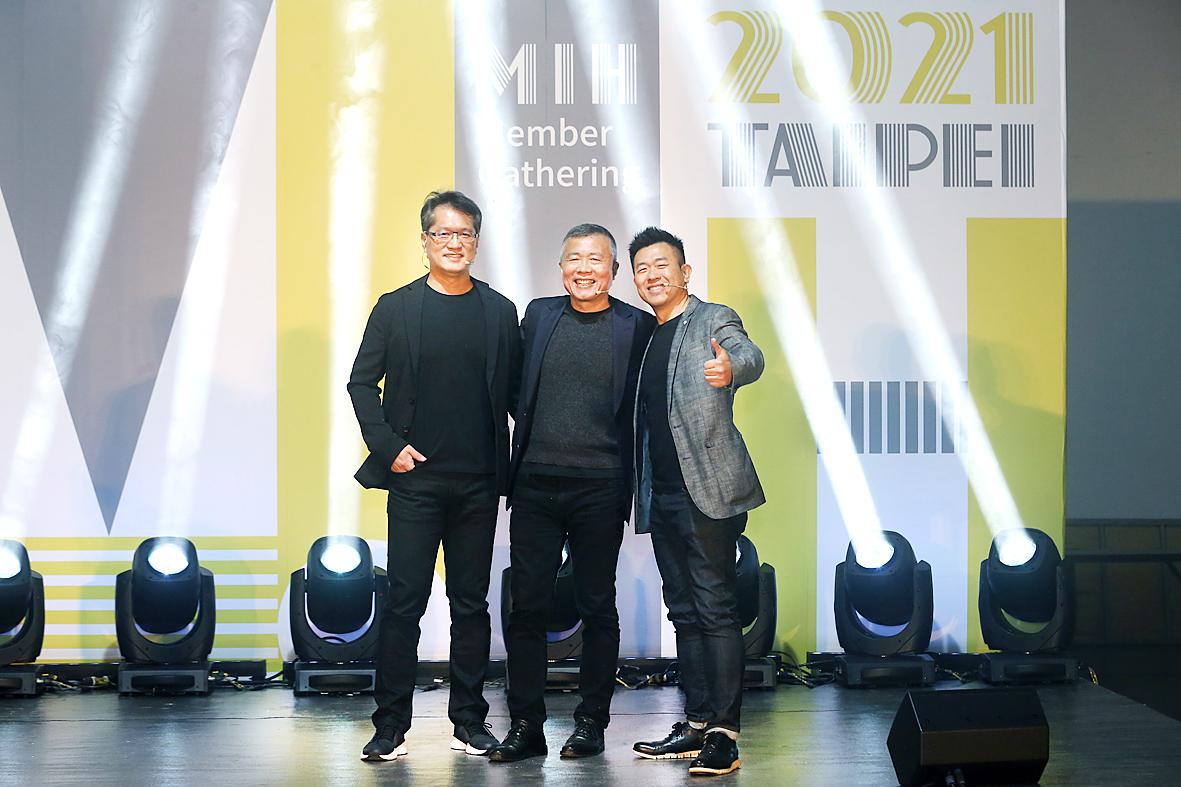Hon Hai Precision Industry Co’s (鴻海精密) MIH platform for electric vehicles (EVs) is to become an independent business unit in July, the company said at the first MIH Open Platform Alliance membership meeting in Taipei yesterday.
More than 1,200 companies in the EV supply chain have joined the alliance since its inception in October last year.
Hon Hai chairman Young Liu (劉揚偉) said that the firm’s goal is to consolidate Taiwan’s EV component makers so that they can cooperate with each other.

Photo: Chen Rou-chen, Taipei Times
“Due to Taiwan’s limited domestic market, it is hard to develop a business-to-consumer model,” Liu said. “However, a platform to bring together all of the nation’s talent on a business-to-business basis is perfect for the development of EVs.”
The development of “software-defined vehicles” was central to the member-only meeting in the Songshan Tobacco Factory in Taipei, which was livestreamed online.
“In the future, you will be able to develop 80 percent of an EV’s functions on the cloud,” Hon Hai chief technology officer William Wei (魏國章) said.
“Our goal is to provide vehicle developers with a complete stack development environment that mimics today’s development environment for consumer electronics,” Wei said. “It will be like what we had for desktop computers for the past 20 years and for smartphones in the past 10 years.”
Wei said that the EV development cycle can be shortened, from five years to two-and-a-half years, and development costs and risks reduced through cloud-based systems.
EV design can be streamlined by “pushing the whole system layer to the application layer,” Wei said.
“We push the domain of battery management into the application layer so that everybody can join in disrupting the space,” he said.
Among the MIH members is Tony Lin (林東閔), chief executive officer of Aeon Motor Co (宏佳騰), a maker of electric scooters.
Lin said that through flexibility in EV development, a whole new mobility market would emerge.
The MIH platform can accommodate vehicles as diverse as busses and microvehicles, he said.
“When you call a Uber you are hiring a five-person sedan with a driver to carry one passenger,” Lin said, referring to the California-based ride-hailing service.
“What if in the future you can just hire a 1-seater autonomous car?” Lin said. “Taiwan needs this alliance to bring us together so we can be seen by the world.”

Taiwan’s long-term economic competitiveness will hinge not only on national champions like Taiwan Semiconductor Manufacturing Co. (TSMC, 台積電) but also on the widespread adoption of artificial intelligence (AI) and other emerging technologies, a US-based scholar has said. At a lecture in Taipei on Tuesday, Jeffrey Ding, assistant professor of political science at the George Washington University and author of "Technology and the Rise of Great Powers," argued that historical experience shows that general-purpose technologies (GPTs) — such as electricity, computers and now AI — shape long-term economic advantages through their diffusion across the broader economy. "What really matters is not who pioneers

In a high-security Shenzhen laboratory, Chinese scientists have built what Washington has spent years trying to prevent: a prototype of a machine capable of producing the cutting-edge semiconductor chips that power artificial intelligence (AI), smartphones and weapons central to Western military dominance, Reuters has learned. Completed early this year and undergoing testing, the prototype fills nearly an entire factory floor. It was built by a team of former engineers from Dutch semiconductor giant ASML who reverse-engineered the company’s extreme ultraviolet lithography (EUV) machines, according to two people with knowledge of the project. EUV machines sit at the heart of a technological Cold

TAIWAN VALUE CHAIN: Foxtron is to fully own Luxgen following the transaction and it plans to launch a new electric model, the Foxtron Bria, in Taiwan next year Yulon Motor Co (裕隆汽車) yesterday said that its board of directors approved the disposal of its electric vehicle (EV) unit, Luxgen Motor Co (納智捷汽車), to Foxtron Vehicle Technologies Co (鴻華先進) for NT$787.6 million (US$24.98 million). Foxtron, a half-half joint venture between Yulon affiliate Hua-Chuang Automobile Information Technical Center Co (華創車電) and Hon Hai Precision Industry Co (鴻海精密), expects to wrap up the deal in the first quarter of next year. Foxtron would fully own Luxgen following the transaction, including five car distributing companies, outlets and all employees. The deal is subject to the approval of the Fair Trade Commission, Foxtron said. “Foxtron will be

INFLATION CONSIDERATION: The BOJ governor said that it would ‘keep making appropriate decisions’ and would adjust depending on the economy and prices The Bank of Japan (BOJ) yesterday raised its benchmark interest rate to the highest in 30 years and said more increases are in the pipeline if conditions allow, in a sign of growing conviction that it can attain the stable inflation target it has pursued for more than a decade. Bank of Japan Governor Kazuo Ueda’s policy board increased the rate by 0.2 percentage points to 0.75 percent, in a unanimous decision, the bank said in a statement. The central bank cited the rising likelihood of its economic outlook being realized. The rate change was expected by all 50 economists surveyed by Bloomberg. The